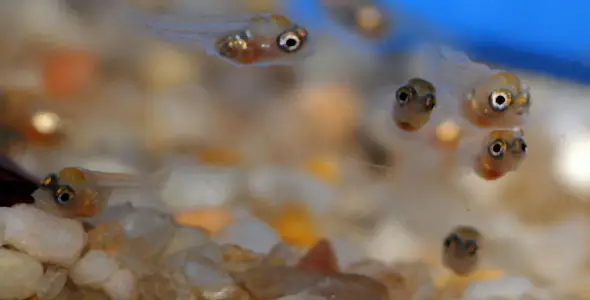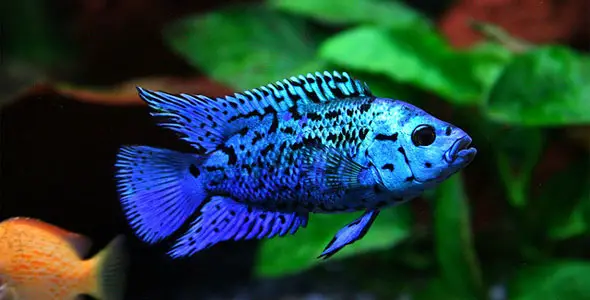It happened when you least expected it; you woke up one morning and discovered a small cloud in your fish tank. Upon closer inspection you learned that the small cloud was actually a grouping of baby fish that seemed to resemble a couple of fish in your tank. You’re a… parent? Fish guardian? Well, whatever you are it’s certainly exciting! A whole flock or herd of baby fish is in your tank, ready to grow into adults. Then as you watch you are horrified to see the other fish in your tank taking dives into the cloud, gulping down mouthfuls of the babies! “Cannibals!” you cry, though you can’t do anything to save the fry because you are unprepared. Here are some tips to help you successfully breed your fish and save the fry from an untimely fate!
1. All My Fishes
Fish are either live-bearers, meaning they carry the eggs in their bodies and release the fry once they have hatched, or they are egg layers and will lay a cloud of eggs on the bottom of the tank. Which fish do you have? Knowing this beforehand will help you be prepared for spawning. Mollies, for example, are live-bearing and are often pregnant. They can hold up to six months worth of fertilized eggs and will release hatched fry every six or so weeks until they have run out of fertilized eggs to hatch!
Egg-layers can be divided into four groups: scatterers, substrate spawners, bubble builders, and mouthy brooders. Scatterers are those fish that in the wild let the eggs roam free on the current. Substrate spawners will attach their eggs to something so they can’t float away. Bubble builders will build a nest made up of bubbles on the underside of leaves where the nest is often guarded by the male. Mouth brooders carry the eggs and fry in their mouth, though some substrate spawners are also mouth brooders.
2. The Bold and the Spawning
The most important thing to give your fish when they are spawning is space! Male fish during spawning season will become exceptionally aggressive and younger, smaller fish can be bullied and even killed by these aggressive males. This is one of the reasons that having an appropriately sized tank is so important!
3. Dynasties
Now that you are aware of the possibility of your fish spawning, you can take action and choose which fish to use to build your fish dynasty. Choosing the right pair is important, not just for the sake of the fry but for the sake of the species. Because your fish are removed from the wider selection of males and females, you have to do the work for them. Choose the fish that have the brightest colors and best markings, as well as good fins, movement, and general vitality since these are signs of excellent health. Fish with good appetites are more desirable than fish that are picky. Make sure your pair gets along well; you will be more successful if they can get along. In addition, if they don’t get along, one may bully the other to death!
Be careful choosing older fish. It is best, whenever possible, to use young fish in their prime. Older fish towards the end of their reproductive cycle should not be used unless they are exceptional in some way. NEVER use unhealthy or subpar fish as you will just perpetuate undesirable genetics.
If you accidentally create a hybrid – the spawn of two different species – make careful note of it and try not to repeat the mistake. Hybrids in most species are sterile and should not be sold as pure fish but as noted hybrids with the parent species listed.
4. Spawning Place
Once you have identified your spawning pair, but before you isolate them, you must put together a spawning tank. When designing the spawning tank, there are a few things to keep in mind:
a. It doesn’t have to be very big as often a tank as small as two gallons will work for the pair, though something closer to six gallons would be nicer.
b. You want to decorate it as ideally as possible; it should resemble the home tank and the fish’s ideal spawning conditions. Each type of spawner has different needs that should be researched.
c. You don’t have to set up a nitrogen cycle or wait around for the water to be perfect as you can use the already perfect water from your main tank. Use a foam or sponge filter for a week or so before building your spawning tank and then just move it into the spawning tank. This will move beneficial bacteria and quickly bring new water into sync with the old water from your tank.
5. Three Steps to Spawning
The next step is to condition the parents so that they know it’s time to begin spawning. This can be achieved through three easy but critical steps:
a. Provide ideal water conditions; these should be as similar to their natural habitat as possible.
b. Keep their needs in mind. Provide crevices and hiding places for security and make sure you are providing a water current if desired, or no current if that is preferred. Lighting and temperature should be ideal. If your fish school, don’t remove them from the group!
c. Feed your fish. Give the best possible food that you can find; live food is best as it seems to inspire them. Feed your fish up to three times a day and remember to clean up after feedings.
Some fish require an additional step: simulated rainfall. These fish are those that would naturally spawn during the rainy season. Simulate the rainy season by reducing the water level in the spawning tank by half, then add 5% of the total aquarium volume each day. The water should be soft and cool. If your fish seem to be stubborn, you can also add a drip system or spray bar to simulate rain falling on the water surface. Repeat as necessary until they show signs of spawning.
6. Spawn of Our Lives
Your fish are ready and so are you. Each type of spawner has different needs once spawning has occurred, so be sure you know what type of spawning occurs and what sort of parents they are before you begin.
Scatterers – Once your scatterers have laid their eggs and fertilized them, you can remove them from the spawning tank and place them back within the community tank. The Spawning tank will double as the delivery and rearing tank for the fry.
Bubble Builders – Are these also mouth brooders? If not, they can be removed from the spawning tank and returned to the community tank. The fry can remain in the spawning tank.
Mouthbrooders – Once these have spawned, you can leave them with their eggs. These parents are very aggressive during spawning and while rearing their fry, so should not be left with the community.
Live Bearers – Many breeders separate the live-bearer from their fry with something called a breeding trap. It has holes large enough for the fry to fall through, but small enough that the parent can’t chase after them and eat them for a snack.





